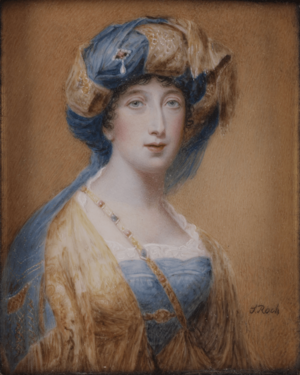Sampson Towgood Roch facts for kids
Quick facts for kids
Sampson Towgood Roch
|
|
|---|---|
 |
|
| Born | 1757 Youghal, County Cork, Ireland
|
| Died | 1847 (aged 89–90) Woodbine Hill, County Waterford
|
| Nationality | Irish |
Sampson Towgood Roch (1757–1847) was a talented Irish artist. He was famous for painting very small, detailed pictures called miniatures. These tiny portraits were popular during his time.
Contents
Early Life and Family
Sampson Towgood Roch was born in 1757 in Youghal, a town in County Cork, Ireland. He was the oldest son of William and Mary Roch. Sampson was born deaf, which means he could not hear.
When he was about 16 years old, in 1773, Sampson visited family in Cashel, County Tipperary. There, he showed a great skill for drawing. He enjoyed sketching landscapes and portraits of his friends and family. It is believed that Sampson taught himself how to paint. He likely knew other artists in Cork, where he lived in 1787. His first known paintings were portraits of his father in 1777 and his mother in 1781.
On May 29, 1787, Sampson married his distant cousin, Melian Roch. Their marriage was arranged, which was common at the time.
Sampson Roch's Art Career
By 1779, Sampson Roch had set up his art business in Dublin. There are no records that he went to art classes or trained with other painters in Dublin. However, he quickly became known for his skill.
In 1782, Roch traveled to England. He painted a portrait of Mrs. Hester Thrale, a friend of the famous writer Samuel Johnson. After returning to Dublin, Roch lived on Capel Street. He became friends with another artist, Horace Hone, who painted a portrait of Sampson in 1785.
Sampson Roch returned to Cork in 1786, then moved back to Dublin in 1788 after his marriage. From 1789 to 1792, he lived on Grafton Street. During this time, he painted many people, including Mrs. Thorp and Mrs. Mangan. Another artist, Charles Byrne, was his student and helped him by acting as his interpreter.
Moving to Bath and Royal Portraits
In 1792, Sampson and Melian Roch moved to Bath, England. His art business really grew there. Roch painted portraits for many important people, including members of the royal family. One of his famous works was a portrait of Princess Amelia of the United Kingdom, the youngest daughter of George III, the King of England.
It is said that he was offered a special honor called a knighthood, but he turned it down because of his deafness. Roch also painted portraits of important figures in Bath, like Charles Le Bas and James King. He also created miniatures of military and naval officers. From 1817 to 1822, he lived on Perpoint Street in Bath.
Later Life and Legacy
Sampson Roch returned to Ireland in 1822 and later stopped painting professionally. He still created some miniatures and sketched scenes of everyday Irish life. He lived at his family home, Woodbine Hill, in County Waterford.
His wife, Melian, passed away in 1837. Sampson Roch died in February 1847 and was buried in the family plot in Ardmore, County Waterford.
In the 20th century, people became more interested in Sampson Roch's artwork. Many of his miniatures were sold, and some were given to the National Gallery of Ireland. Sampson Roch had a unique style. Unlike many artists of his time, he often painted his subjects with a smile or a grin.
Selected Miniatures
- James Roch (1786)
- Ambrose Roch (1788)
- Mr Lee
- Mrs Piozzi (1782)
- Mr Smith of Ballynatray
- Portrait of a Lady (1805)
- Portrait of a Gentleman (1805)
- Lady Kingsmill (1820)


